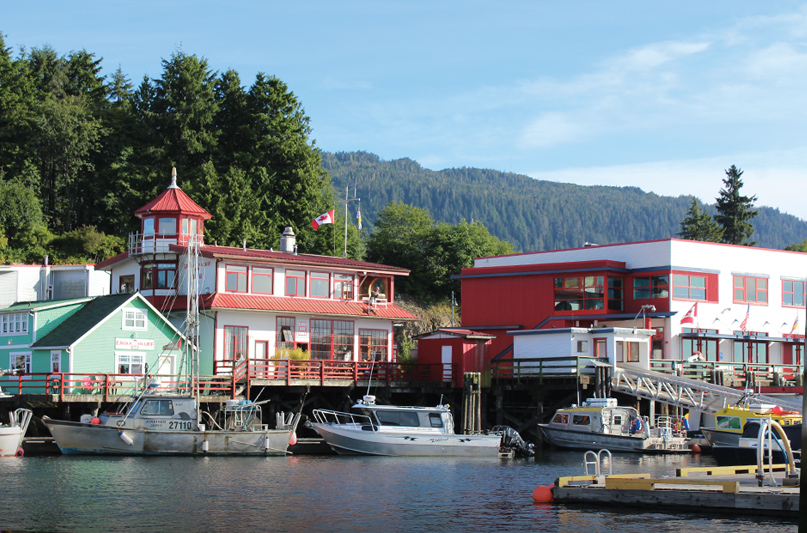
 Prince Rupert, British Columbia, is an important dot on the chart for boaters. Sitting on the northern shore of Kaien Island, the town’s roles as a crossroads and terminus are core to its identity. It’s the western terminus of the Yellowhead Highway (Trans-Canada Highway 16), and by sea, Prince Rupert hosts both major container ship and passenger ferry terminals. The airport is an essential link to the greater world, a useful asset for boaters and landlubbers alike.
Prince Rupert, British Columbia, is an important dot on the chart for boaters. Sitting on the northern shore of Kaien Island, the town’s roles as a crossroads and terminus are core to its identity. It’s the western terminus of the Yellowhead Highway (Trans-Canada Highway 16), and by sea, Prince Rupert hosts both major container ship and passenger ferry terminals. The airport is an essential link to the greater world, a useful asset for boaters and landlubbers alike.
If you’re on a boat, passing Prince Rupert means you’re fresh from the glacier studded waters of Alaska and going south or leaving a long cruise through British Columbia behind as you head north. The town is a great place to duck in if the weather fouls in the exposed Dixon Entrance.
Culturally, Prince Rupert is an expression of a unique demographic mix for a town of 12,000 people. Canadian 2016 Census data reports about 12.4 percent of the population is of primarily Asian minority groups: Filipino, South Asian, Chinese, and Southeast Asian. First Nations peoples make up about 38.9 percent of the population, while Caucasians make up 48.7 percent of the population.
As a result, a rich blend of heritages, art, and food can be found, especially for a town of this size. Sushi restaurants using locally caught seafood are found next to galleries of First Nations artwork, and the flags of Nordic countries fly high in homage to immigrants who helped found the town. The visitor-oriented downtown is flanked by seafood processing plants and warehouses, the commercial vessels outnumbering the recreational boats.
While the town’s economy experienced ups and downs, certain developments trend positively. A major pulp mill reopened in 2005 (the same year as the container ship port construction) and the addition of a cruise ship terminal in 2004 were big steps toward establishing tourism and industry economies. What’s next? Who knows, but hopefully the hardworking locals can catch a break.
By boat, you can enter Cow Bay from the south between Digby Island and Kaien Island, or from the west between Digby Island and the town of Metlakatla. The southern entrance is large and mostly obstacle free, but mind the commercial and ferry vessels passing through. The western entrance is more complex with islands and shoals to navigate, so don’t get coy with the channel markers.
STAY AWHILE
LOCAL PRINCE RUPERT HIGHLIGHTS
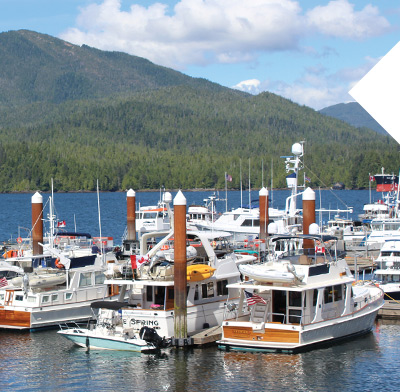
|
Waterfront WanderingsCow Bay Marina is right in the middle of it all, with a hub of small businesses and the Prince Rupert Visitor Information Centre right at the entrance. The Ice House Gallery is an artist cooperative with the work of North Coast creators and a great place to pick up mementos. The Information Centre and neighboring Port Interpretive Centre are also good stops to get your bearings. Boat watching, especially in the busy summer months, is premium with day-fishing charters, historic wooden vessels, visiting yachts, and more. This waterfront is also strategically located within walking distance to the local sights both north and south. |
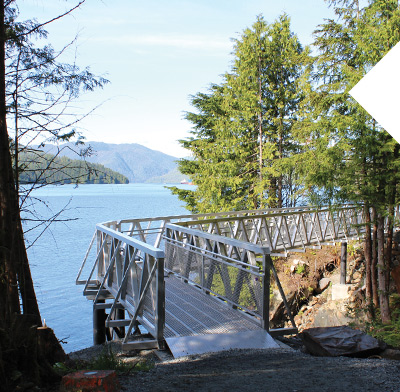
|
Greenspace AplentyThere’s plenty of greenspace in Prince Rupert to explore in all directions from the waterfront. South along the water, one finds Rotary Waterfront Park, made iconic because of the old abandoned railroad station on the premises. There’s a small Kwinitsa Railway Museum for the curious. Northward you pass a mile or so of industrial buildings along George Hills Way and a few cow-themed garbage cans before reaching Rushbrook Harbour and Bob’s On the Rocks eatery before the Rushbrook Trail. If you’re a golf fan, the Prince Rupert Golf Club isn’t far from the water and is open to the public. You can learn more about them at princerupertgolf.com. |
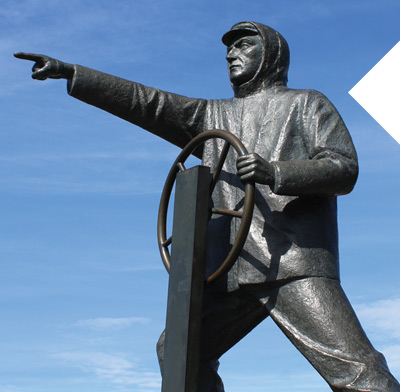
|
Seafaring HeritagePacific Mariners Memorial Park is prominent next to the Museum of Northern British Columbia and a great place to catch a view or rally for a picnic. Memorials to fishermen, Nordic immigrants, and the Kazu Maru Memorial pay homage to the sea. Another recommended sight is the North Pacific Cannery, located several miles south of downtown. The cannery is now a major museum with guided tours, exhibits, and regular events. It stands much as it did during its days of operation from 1888 to the late 1970s, making it the longest running cannery in B.C. history. There are many ways to get down there, including a bus ride that costs $2.75 CAD each way. Check out northpacificcannery.ca for more information. |
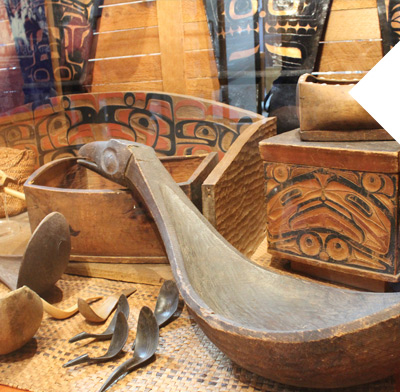
|
Cultural ImmersionRemote towns like Prince Rupert tend to be a magnet for local culture, and there are plenty of opportunities for visitors to get a glimpse. The excellent Museum of Northern British Columbia sits prominently on a bluff overlooking Cow Bay Road. The building is constructed in the style of a large rustic longhouse; art, artifacts, and history from First Nations, settlers, and contemporaries are plentiful within. This museum is a must for visitors, and you can check for updates and hours at museumofnorthernbc.com. Also worth a look is the small but charming Prince Rupert Fire Museum, located a block away from the Museum of Northern British Columbia. Operated by dedicated current and former Prince Rupert City Fire Rescue and auxiliary members, the museum features 1925 R.E.O Speedwagon and 1958 American LaFrance firefighting vehicles, the few (if not only) of their kind in existence. |
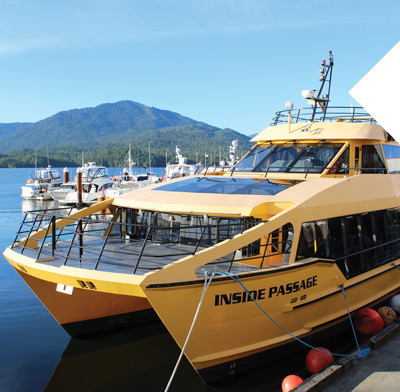
|
Call of the WildThe town serves as an excellent gateway to some great wilderness, notably the Khutzeymateen Grizzly Bear Sanctuary to the northeast on the mainland. The protected area has a strict permitting policy that can make it difficult for private boaters to visit on their own hull, so the best way to enter this world-class wilderness is often to hop on one of the local charter boats that take visitors out there. Prince Rupert Adventure Tours is one such company that has an office right on the waterfront by Cow Bay Marina, and you can check them out at adventuretours.net. |
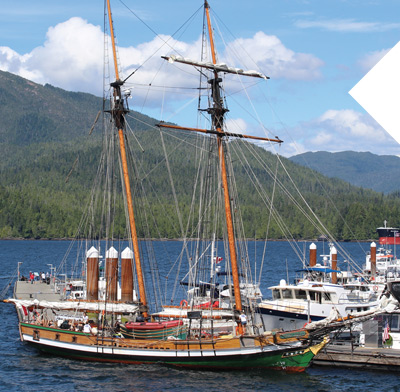
|
Jump ShipIn addition to ecotourism charters, day fishing charters are an alluring local offering. There are dozens of privately owned, mom-and-pop style fishing charters that will happily take you and your crew out for a day to fill up the freezer with salmon, halibut, crab, spot prawns, and more depending on the season. If interested, ask around the Visitor Information Centre or the docks for someone good, those word of mouth recommendations can be gold. Didn’t have space to pack a kayak? Outfitters like Skeena Kayaking rent kayaks plus provide tours and lessons. When I was in town last August, the tallship Pacific Swift was in port and taking folks out for afternoon and sunset sails. The tallship, which has a sparred length of 111′ and is owned by SALTS (Sail and Life Training Society), is an educational and tourism platform. If you see them around, strike up a conversation and see if you can score an experience. |
PRINCE RUPERT, BRITISH COLUMBIA
GASTRONOMY
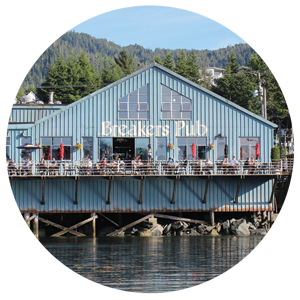
If you want to play to the area’s strengths, you’ll start the morning with regionally roasted cups of coffee, dive into seafood fresh from the saltchuck, and rounding out the evening pints of local microbrews. For coffee, you must check out Cowpuccino’s Coffee House during your stay. The coffee is great and the café seems to be full of locals most of the time (a good sign).
The options really open up when it comes to seafood. There is a strong B.C.-style sushi presence between the waterfront Fukasaku of Prince Rupert and Opa Sushi restaurants. Both feature unique dishes where the local seafood is the star of the show. Outside of the sushi-sphere, I was blown away by the food at Dolly’s Fish Market, located across the street from Opa Sushi on Cow Bay Road. Entrees like the Stuffed Halibut Cordon Bleu [$31.95 CAD]—a halibut filet stuffed with local shrimp, Dungeness crab meat, Havarti herb cheese, and melted herb butter—is just so many good things crammed onto one plate it shouldn’t be legal. Smoked salmon, steamed mussels, fried oysters, and more overload the menu.
If brews with views is the priority, you can head up past the Pacific Mariners Memorial Park to restaurants Cargo Kitchen, Waterfront Restaurant, and Don Cherry’s Sports Grill, or stay by the marinas at Smile’s Seafood Café or Breakers Pub. Breakers is a magnet for locals and tourists alike, and I was thoroughly trounced at darts there by a pair of friendly Dutch visitors. Wheelhouse Brewing is housed in a nautical-themed stone building. Wheelhouse beers are served on tap throughout town, but their tasting room and retail store is worth a visit.